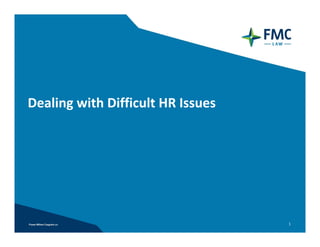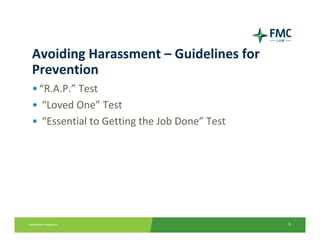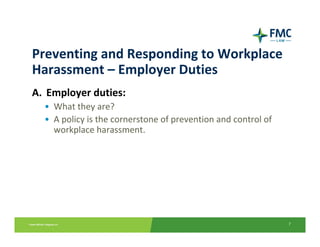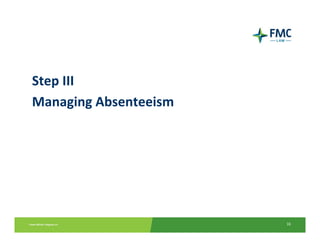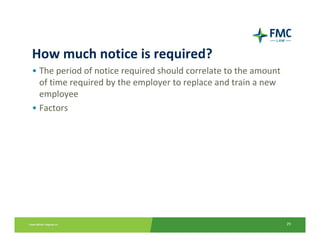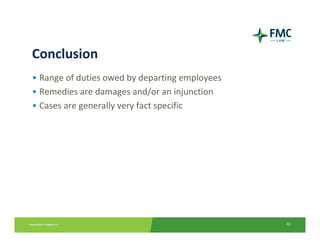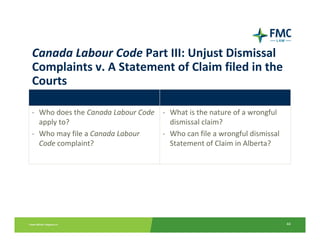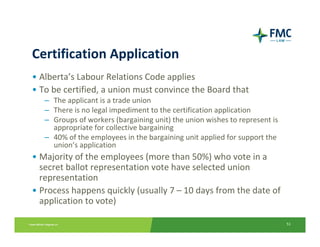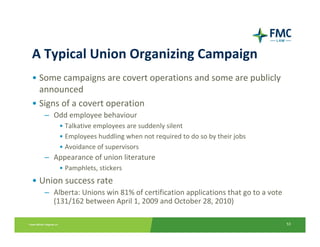Dealing with Difficult HR Issues
- 2. Employee Harassment Issues Presenter: Joe Hunder Partner Labour and Employment 2
- 3. Introduction • Workplace and sexual harassment is unwanted and offensive behaviour. Both are unlawful. • Employers are under a duty to prevent workplace and sexual harassment and to respond appropriately. • Practical and legal consequences. 3
- 4. Recognizing Harassment A. What is “Workplace Harassment”? • Unwelcome conduct that is offensive in nature. • Elements of unwelcome conduct • Characteristics of “offensive in nature” • Could the behaviour reasonably offend, humiliate or intimidate the person to whom it is directed? • Examples 4
- 5. Recognizing Harassment B. Sexual Harassment • What is it? • Key Characteristics • Examples 5
- 6. Avoiding Harassment – Guidelines for Prevention • “R.A.P.” Test • “Loved One” Test • “Essential to Getting the Job Done” Test 6
- 7. Preventing and Responding to Workplace Harassment – Employer Duties A. Employer duties: • What they are? • A policy is the cornerstone of prevention and control of workplace harassment. 7
- 8. Preventing and Responding to Workplace Harassment – Employer Duties B. Harassment Policies: • Contents • Implementation and Enforcement • Provide copies • Ensure consistent application and adherence 8
- 9. Absenteeism and the Duty to Accommodate Presenter: Adrian Elmslie Partner Labour and Employment 9
- 11. Making sure the correct information is collected • Be clear about whose responsibility it is to keep track of or report employee absences. • Maintain written records. • Institute a call in policy for all unscheduled absences. • Make sure you find out why the employee is absent from work. • Use the Information 11
- 13. Types of Absenteeism Generally there are two categories of absenteeism: a) culpable absenteeism; and b) innocent absenteeism i) caused by transient ailments ii) caused by a disability 13
- 14. Culpable Absenteeism Absences within the employee’s control and for which there is no justifiable or reasonable excuse. Examples: • sleeping in • failure to arrange transportation • lateness or inability to work due to physical or mental conditions within the employee’s control • absences that are not supported by medical verification where requested or required 14
- 15. Innocent Absenteeism – Disability or Transient Ailment? Absences that are beyond the employee’s control. • Is the condition permanent or ongoing? (A temporary condition is not a disability unless it recurs as part of a medical condition). • Is the condition so serious that it restricts life’s important functions? • Is the condition common to the broader public? (e.g. the common cold, no matter how severe, is not a disability). 15
- 17. Culpable Absenteeism • Dealt with the same way as other types of misconduct. • Best way to ensure consistency and to avoid problems is to have a written attendance policy. • Attendance policy should include the following elements: – Statement of Attendance Expectations – Reporting Procedure – Medical Notes – Disciplinary Measures 17
- 18. Managing Innocent Absenteeism Transient Ailments • Focus on verifying that the reason for the absence is legitimate and assisting or encouraging the employee to correct the cause through counselling or other means. 18
- 19. Managing Innocent Absenteeism Disabilities • Duty not to discriminate under s.7 of the Human Rights Act • Duty to accommodate disabilities • Must accommodate to the point of “undue hardship” • Employees must cooperate in the accommodation process 19
- 21. Obligations of the Departing Employee Presenter: Cristina Wendel Associate Labour and Employment 21
- 22. Obligations of Departing Employees • Employee obligations at law • Contractual obligations • Remedies 22
- 23. What obligations does a departing employee owe to the employer? • Obligations arise from 3 basic sources 1) Common law duties 2) Fiduciary duties 3) Contractual duties 23
- 26. Duty of good faith and fidelity – what does it include? • Continuing obligations after employment has ended – Duty not to misappropriate confidential information 26
- 27. Duty of good faith and fidelity – what does it not include? • Generally does not prohibit solicitation of clients or employees after employment has ended • Generally does not prohibit competition – Exceptions: • While employed, cannot take preparatory steps to set up the competing business during working hours or on the employer’s premises • Cannot use confidential or proprietary information belonging to the former employer when competing 27
- 28. Duty to give reasonable notice of termination of employment • An employee is required to give its employer reasonable notice of his or her intention to resign • The employee is prohibited from competing with the employer during this period • Confirmed in the 2007 ABQB decision in Torcana Valve Services Inc. v Anderson 28
- 29. How much notice is required? • The period of notice required should correlate to the amount of time required by the employer to replace and train a new employee • Factors 29
- 30. Fiduciary Duties • Who is a fiduciary? • What additional obligations are owed by fiduciaries? • How long are those duties owed to the former employer? 30
- 31. Fiduciary Duties – who is bound? • Variety of tests set out in the case law • The determination is fact specific • Must look at the employee’s actual powers and responsibilities – job titles are not determinative • Usually there are 3 general characteristics to a fiduciary relationship: – The employee has the scope for the exercise of discretion or power – The employee can unilaterally exercise that discretion or power to affect the employer – The employer is vulnerable • “Key” or higher level employees 31
- 32. Fiduciary duties – what are the additional obligations? • Cannot take a maturing business opportunity from the employer either during or after the term of employment • Competition with the former employer after the term of employment in and of itself is not automatically a breach – BUT the right to compete is qualified ‐ the employee cannot actively solicit the former employer’s clients for a reasonable period of time. 32
- 34. Contractual Duties • Confidentiality agreements • Restrictive Covenants – Non‐solicitation – Non‐competition 34
- 35. Confidentiality Agreements • Useful to define and clarify what is considered confidential or proprietary information and clearly impose the restrictions on the use of that information 35
- 36. Restrictive Covenants • Key Case – Shafron v. KRG Insurance Brokers (Western) Inc., 2009 SCC – Recognized the tension between the freedom to contract and the public policy on restraint of trade • Presumption that restrictive covenants will generally be unenforceable as being in restraint of trade • Exception – where the restrictive covenant is reasonable, it will be upheld – Confirmed the need for increased scrutiny for covenants arising in employment contracts as opposed to the sale of a business 36
- 37. What constitutes a reasonable restrictive covenant • Depends on the particular facts and circumstances • Basic factors for reasonableness: – Must protect a legitimate proprietary interest – Must be reasonable in terms of: • Time • Geographic area • Nature of activities prohibited – Terms must be clear, certain and not ambiguous – Must be reasonable with respect to the public interest 37
- 38. Drafting Restrictive Covenants • Notional severance • Courts will not rewrite ambiguous clauses to make them enforceable – Ambiguous clauses are considered unreasonable – Clauses with descending restrictions will not be enforced • “Blue line” or “blue pencil” severance – an offending part of a clause may be removed where that part is trivial and not part of the main substance 38
- 39. Remedies • Two main remedies available – Damages – Injunction 39
- 40. Damages • Intended to put the former employer back in the position it would have been in had the breach not occurred • Where the employee has competed in breach of his or her duties, the former employer has a choice for the measure of damages: – its lost profits; or – the profits gained by the former employee and the competing business 40
- 41. Injunction • Interlocutory – i.e. prior to trial • To restrain the former employee from continuing the breach • 3 part test: – Prima facie case – Irreparable harm – Balance of convenience favours the employer 41
- 42. Conclusion • Range of duties owed by departing employees • Remedies are damages and/or an injunction • Cases are generally very fact specific 42
- 43. Canada Labour Code Part III: Unjust Dismissal Complaints v. A Statement of Claim filed in the Courts Presenter: Colleen Verville Partner Labour and Employment 43
- 44. Canada Labour Code Part III: Unjust Dismissal Complaints v. A Statement of Claim filed in the Courts ‐ Who does the Canada Labour Code ‐ What is the nature of a wrongful apply to? dismissal claim? ‐ Who may file a Canada Labour ‐ Who can file a wrongful dismissal Code complaint? Statement of Claim in Alberta? 44
- 45. Canada Labour Code Part III: Unjust Dismissal Complaints v. A Statement of Claim filed in the Courts ‐ What is the cost to file an unjust ‐ What is the cost for filing a dismissal complaint? Statement of Claim? 45
- 46. Canada Labour Code Part III: Unjust Dismissal Complaints v. A Statement of Claim filed in the Courts ‐ What is the time limitation for filing ‐ What is the time limitation for filing an unjust dismissal complaint? a wrongful dismissal Statement of Claim? 46
- 47. Canada Labour Code Part III: Unjust Dismissal Complaints v. A Statement of Claim filed in the Courts ‐ What is the process to file an ‐ What is the process in the Courts? unjust dismissal complaint? 47
- 48. Canada Labour Code Part III: Unjust Dismissal Complaints v. A Statement of Claim filed in the Courts ‐ What are the powers of an ‐ What are the powers of the adjudicator? Courts? 48
- 49. Canada Labour Code Part III: Unjust Dismissal Complaints v. A Statement of Claim filed in the Courts ‐ Can the adjudicator’s decision be ‐ Can the Court’s decision be appealed? appealed? 49
- 50. How Unions Acquire the Legal Right to Represent Alberta Employees and Adopting a Union Free Philosophy Presenter: Fausto Franceschi Partner Labour and Employment 50
- 51. Certification Application • Alberta’s Labour Relations Code applies • To be certified, a union must convince the Board that – The applicant is a trade union – There is no legal impediment to the certification application – Groups of workers (bargaining unit) the union wishes to represent is appropriate for collective bargaining – 40% of the employees in the bargaining unit applied for support the union’s application • Majority of the employees (more than 50%) who vote in a secret ballot representation vote have selected union representation • Process happens quickly (usually 7 – 10 days from the date of application to vote) 51
- 52. A Typical Union Organizing Campaign • Employees may invite the union to organize their workplace or the union may proceed without an invitation • A union gauges depth of employee support • A union attempts to develop a cast of “inside organizers” • Obtaining employee support – union card or petition • What unions sell. What workers buy. – Higher wages – Better benefits, including pensions – Job security – Seniority rights – Protection from an employer’s arbitrary actions (grievances) – A bigger say in the workplace – A safer workplace – “Insurance” 52
- 53. A Typical Union Organizing Campaign • Some campaigns are covert operations and some are publicly announced • Signs of a covert operation – Odd employee behaviour • Talkative employees are suddenly silent • Employees huddling when not required to do so by their jobs • Avoidance of supervisors – Appearance of union literature • Pamphlets, stickers • Union success rate – Alberta: Unions win 81% of certification applications that go to a vote (131/162 between April 1, 2009 and October 28, 2010) 53
- 54. Employer Responses: Strategy • Unfair Labour Practices – What are they? – Legal and Practical Consequences • Role of supervisors (inside and outside of the campaign) • Intensity of Response – depends on each situation • Communication plan (lawful) is essential 54
- 55. Union Free Philosophy • Have a union free philosophy (be a “pro‐employee” organization) • Employees are unlikely to want third party union representation if they are working for you and feel valued – Fair wages and benefits – Invite employee feedback – Opinion polls – Open door policy (as opposed to a false open door policy) – Listen to employee concerns – Have an issue free workplace philosophy – Strive for high morale (get rid of jerks) – Leadership needs to have a presence with employees – Being union free is a process, therefore devote time to it – it will make you a better company, as well as keeping you union free 55
- 56. Questions?
- 57. Thank you for Joining Us Joe Hunder 780.423.7354 e: joe.hunder@fmc‐law.com Adrian Elmslie 780.423.7364 e: adrian.elmslie@fmc‐law.com Cristina Wendel 780.423.7353 e: cristina.wendel@fmc‐law.com Fausto Franceschi 780.423.7348 e: fausto.franceschi@fmc‐law.com Colleen Verville 780.423.7103 e: colleen.verville@fmc‐law.com

